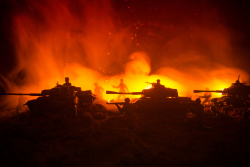by Marelie Manders, Heidelberg IWC and Human Rights Team Co-Chair
On November 6, the International Day for Preventing the Exploitation of the Environment in War and Armed Conflict was observed and has been observed as a special day designated by the United Nations since 2001.
 Armed conflicts have always affected the natural environment. Over time parties to armed conflicts have, for example, poisoned soil, polluted water and cut down forests in their search for military advantage. One only has to look at the destruction in Mosul (read more here) to see the possible severity of damage to the environment during conflicts as well as the possible effects on civilian health. The environmental effects of such conflicts are not always short-lived; they may, in fact, be long-lasting and continue for years after peace is concluded.
Armed conflicts have always affected the natural environment. Over time parties to armed conflicts have, for example, poisoned soil, polluted water and cut down forests in their search for military advantage. One only has to look at the destruction in Mosul (read more here) to see the possible severity of damage to the environment during conflicts as well as the possible effects on civilian health. The environmental effects of such conflicts are not always short-lived; they may, in fact, be long-lasting and continue for years after peace is concluded.
Over 80 percent of the major armed conflicts between 1950 and 2000 were fought directly in biodiversity hotspots. In addition, in the last 60 years at least 40 percent of internal armed conflicts have been connected to the exploitation of natural resources. It has also been found that these types of conflicts are very likely to relapse. This highlights the importance of protecting the environment during armed conflicts, and the importance of marking this day.
Internationally, the treatment of the environment during armed conflict is regulated by the Additional Protocol I to the Geneva Conventions. In this instrument, the environment is protected both directly and indirectly through certain rules. Along with some other protections, this international agreement prevents methods or means of warfare which are intended, or may be expected, to cause “widespread, long-term and severe damage” to the natural environment. This could be, for example, attacks that cause damage across a large area, remaining for a long time and harming the ecosystem or the health of the population on a large scale.
The Convention on the Prohibition of Military or Any Other Hostile Use of Environmental Modification Techniques (ENMOD) furthermore prohibits the military or any other hostile use of environmental modification techniques having “widespread, long-lasting or severe” effects. This covers instances where the environment itself is used as a weapon: for example, attacks on water infrastructure.
A lot of work has also been done in the last few years by the International Law Commission as well as the International Committee of the Red Cross, both adopting draft principles and guidelines for the protection of the natural environment during armed conflicts. These principles, guidelines and recommendations are a welcome step in the development of additional protection for the natural environment, and could possibly lead to new legal instruments being adopted in future.
Sources:
Analytical Guide to the Work of the International Law Commission | International Law Commission
Protecting the Environment in Armed Conflict | Geneva Environment Network

